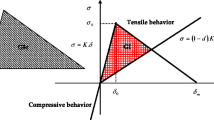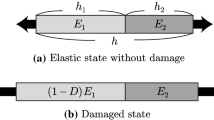Abstract
Most building materials can be characterized as quasi-brittle composites with a cementitious matrix, reinforced by some stiffening particles or elements. Their massive exploitation motivates the development of numerical modelling and simulation of behaviour of such material class under mechanical, thermal, etc. loads, including the evaluation of the risk of initiation and development of micro- and macro-fracture. This paper demonstrates the possibility of certain deterministic prediction, applying the dynamical approach using the Kelvin viscoelastic model and cohesive interface properties. The existence and convergence results rely on the semilinear computational scheme coming from the method of discretization in time, using several types of Rothe sequences, coupled with the extended finite element method (XFEM) for practical calculations. Numerical examples refer to cementitious samples reinforced by short steel fibres, with increasing number of applications as constructive parts in civil engineering.
Similar content being viewed by others
References
S. B. Alton: Existence in nonlocal elasticity. Arch. Mech. 41 (1989), 25–36.
I. Babuška, J. M. Melenk: The partition of unity method. Int. J. Numer. Methods Eng. 40 (1997), 727–758.
T. Belytschko, T. Black: Elastic crack growth in finite elements with minimal remeshing. Int. J. Numer. Methods Eng. 45 (1999), 601–620.
A. Bermúdez de Castro: Continuum Thermomechanics. Progress in Mathematical Physics 43. Birkhäuser, Basel, 2005.
G. S. Bhatia, G. Arora: Radial basis function methods for solving partial differential equations: A review. Indian J. Sci. Technol. 9 (2016), Article ID 45, 18 pages.
L. Bouhala, A. Makradi, S. Belouettar, H. Kiefer-Kamal, P. Fréres: Modelling of failure in long fibres reinforced composites by X-FEM and cohesive zone model. Composites B, Eng. 55 (2013), 352–361.
J. K. Bunkure: Lebesgue-Bochner spaces and evolution triples. Int. J. Math. Appl. 7 (2019), 41–52.
A. Cianchi, V. Maz’ya: Sobolev inequalities in arbitrary domains. Adv. Math. 293 (2016), 644–696.
D. S. Clark: Short proof of a discrete Gronwall inequality. Discrete Appl. Math. 16 (1987), 279–281.
G. Dal Maso, G. Lazzaroni: Crack growth with non-interpenetration: A simplified proof for the pure Neumann problem. Discrete Contin. Dyn. Syst. 31 (2011), 1219–1231.
G. Del Piero, D. R. Owen: Structured deformations of continua. Arch. Ration. Mech. Anal. 124 (1993), 99–155.
L. Dlouhý, S. Pouillon: Application of the design code for steel-fibre-reinforced concrete into finite element software. Beton 116 (2020), 8–13.
P. Drábek, J. Milota: Methods of Nonlinear Analysis: Applications to Differential Equations. Birkhäuser Advanced Texts. Basler Lehrbücher. Birkhäuser, Basel, 2013.
J. Eliáš, M. Vořechovský, J. Skoček, Z. P. Bažant: Stochastic discrete meso-scale simulations of concrete fracture: Comparison to experimental data. Eng. Fract. Mech. 135 (2015), 1–16.
E. Emmrich, D. Puhst: Measure-valued and weak solutions to the nonlinear peridynamic model in nonlocal elastodynamics. Nonlinearity 28 (2015), 285–307.
A. C. Eringen: Theory of Nonlocal Elasticity and Some Applications. Technical Report 62. Princeton University Press, Princeton, 1984.
A. C. Eringen: Nonlocal Continuum Field Theories. Springer, New York, 2002.
A. Evgrafov, J. C. Bellido: From non-local Eringen’s model to fractional elasticity. Math. Mech. Solids 24 (2019), 1935–1953.
T.-P. Fries, T. Belytschko: The intrinsic XFEM: A method for arbitrary discontinuities without additional unknowns. Int. J. Numer. Methods Eng. 68 (2006), 1358–1385.
Z. Gao, L. Zhang, W. Yu: A nonlocal continuum damage model for brittle fracture. Eng. Fract. Mech. 189 (2018), 481–500.
C. Giry, F. Dufour, J. Mazars: Stress-based nonlocal damage model. Int. J. Solids Struct. 48 (2011), 3431–3443.
S. Grija, D. Shanthini, S. Abinaya: A review on fiber reinforced concrete. Int. J. Civil Eng. Technol. 7 (2016), 386–392.
K. Hashiguchi: Elastoplasticity Theory. Lecture Notes in Applied and Computational Mechanics 69. Springer, Berlin, 2014.
P. Havlásek, P. Grassl, M. Jirásek: Analysis of size effect on strength of quasi-brittle materials using integral-type nonlocal models. Eng. Fract. Mech. 157 (2016), 72–85.
A. Hoekstra: Design methodologies for steel-fibre-reinforced concrete and a new methodology for a real time quality control. Beton 116 (2020), 44–49.
C. O. Horgan: Eigenvalue estimates and the trace theorem. J. Math. Anal. Appl. 69 (1979), 231–242.
A. Javili, R. Morasata, E. Oterkus, S. Oterkus: Peridynamics review. Math. Mech. Solids 24 (2019), 3714–3739.
M. Jirásek: Damage and smeared crack models. Numerical Modeling of Concrete Cracking. CISM Courses and Lectures 532. Springer, Wien, 2011, pp. 1–49.
M. Kaliske, H. Dal, R. Fleischhauer, C. Jenkel, C. Netzker: Characterization of fracture processes by continuum and discrete modelling. Comput. Mech. 50 (2012), 303–320.
P. Kawde, A. Warudkar: Steel fibre reinforced concrete: A review. Int. J. Eng. Sci. Res. Technol. 6 (2017), 130–133.
A. R. Khoei: Extended Finite Element Method: Theory and Applications. Wiley Series in Computational Mechanics. John Wiley & Sons, New York, 2015.
V. Kozák, Z. Chlup: Modelling of fibre-matrix interface of brittle matrix long fibre composite by application of cohesive zone method. Key Eng. Materials 465 (2011), 231–234.
V. Kozák, Z. Chlup, P. Padělek, I. Dlouhý: Prediction of the traction separation law of ceramics using iterative finite element modelling. Solid State Phenomena 258 (2017), 186–189.
M. Lazar, G. A. Maugin, E. C. Aifantis: On a theory of nonlocal elasticity of bi-Helm-holtz type and some applications. Int. J. Solids Struct. 43 (2006), 1404–1421.
G. Lazzaroni: Quasistatic crack growth in finite elasticity with Lipschitz data. Ann. Mat. Pura Appl. (4) 190 (2011), 165–194.
X. Li, J. Chen: An extended cohesive damage model for simulating arbitrary damage propagation in engineering materials. Comput. Methods Appl. Mech. Eng. 315 (2017), 744–759.
X. Li, W. Gao, W. Liu: A mesh objective continuum damage model for quasi-brittle crack modelling and finite element implementation. Int. J. Damage Mech. 28 (2019), 1299–1322.
R. W. Macek, S. A. Silling: Peridynamics via finite element analysis. Finite Elem. Anal. Des. 43 (2007), 1169–1178.
Z. Majdisova, V. Skala: Radial basis function approximations: Comparison and applications. Appl. Math. Modelling 51 (2017), 728–743.
A. Mielke, T. Roubíček: Rate-Independent Systems: Theory and Applications. Applied Mathematical Sciences 193. Springer, New York, 2015.
M. Moradi, A. R. Bagherieh, M. R. Esfahani: Constitutive modeling of steel fiber-reinforced concrete. Int. J. Damage Mech. 29 (2020), 388–412.
M. Morandotti: Structured deformation of continua: Theory and applications. Mathematical Analysis of Continuum Mechanics and Industrial Applications II. Springer, Singapore, 2018, pp. 125–136.
N. Nakamura: Extended Rayleigh damping model. Front. Built Environ. 2 (2016), Article ID 14, 13 pages.
R. H. J. Peerlings, R. de Borst, W. A. M. Brekelmans, M. Geers: Gradient enhanced damage modelling of concrete fracture. Mech. Cohesive-frictional Mater. 3 (1998), 323–342.
G. Pijaudier-Cabot, J. Mazars: Damage models for concrete. Section 6.13. Handbook of Materials Behavior Models. Volume II (J. Lemaitre, ed.). Academic Press, London, 2001, pp. 500–512.
M. G. Pike, C. Oskay: XFEM modeling of short microfiber reinforced composites with cohesive interfaces. Finite Elem. Anal. Des. 106 (2005), 16–31.
Yu. Z. Povstenko: The nonlocal theory of elasticity and its application to the description of defects in solid bodies. J. Math. Sci. 97 (1999), 3840–3845.
P. Ray: Statistical physics perspective of fracture in brittle and quasi-brittle materials. Philos. Trans. R. Soc. Lond., Ser. A, Math. Phys. Eng. Sci. 377 (2019), Article ID 20170396, 13 pages.
K. Rektorys: The Method of Discretization in Time and Partial Differential Equations. Mathematics and Its Applications 4. D. Reidel, Dordrecht, 1982.
T. Roubíček: Nonlinear Partial Differential Equations with Applications. ISNM. International Series of Numerical Mathematics 153. Birkhäuser, Basel, 2005.
T. Roubíček: Thermodynamics of rate-independent processes in viscous solids at small strains. SIAM J. Math. Anal. 42 (2010), 256–297.
M. Šilhavý: The general form of the relaxation of a purely interfacial energy for structured deformations. Math. Mech. Complex Syst. 5 (2017), 191–215.
X. T. Su, Z. J. Yang, G. H. Liu: Monte Carlo simulation of complex cohesive fracture in random heterogeneous quasi-brittle materials: A 3D study. Int. J. Solids Struct. 47 (2010), 2336–2345.
Y. Sumi: Mathematical and Computational Analyses of Cracking Formation. Mathematics for Industry (Tokyo) 2. Springer, Tokyo, 2014.
E. Svenning, F. Larsson, M. Fagerström: A two-scale modeling framework for strain localization in solids: XFEM procedures and computational aspects. Comput. Struct. 211 (2019), 43–54.
R. F. Swati, L. H. Wen, H. Elahi, A. A. Khan, S. Shad: Extended finite element method (XFEM) analysis of fiber reinforced composites for prediction of micro-crack propagation and delaminations in progressive damage: A review. Microsyst. Technol. 25 (2019), 747–763.
J. Vala: Structure identification of metal fibre reinforced cementitious composites. Algoritmy: 20th Conference on Scientific Computing. STU Bratislava, Bratislava, 2016, pp. 244–253.
J. Vala, V. Kozák: Computational analysis of quasi-brittle fracture in fibre reinforced cementitious composites. Theor. Appl. Fract. Mech. 107 (2020), Article ID 102486, 8 pages.
Author information
Authors and Affiliations
Corresponding author
Additional information
This research has been supported by the project FAST-S-20-6294 of specific university research at Brno University of Technology.
Rights and permissions
About this article
Cite this article
Vala, J., Kozák, V. Non-local damage modelling of quasi-brittle composites. Appl Math 66, 815–836 (2021). https://doi.org/10.21136/AM.2021.0281-20
Received:
Published:
Issue Date:
DOI: https://doi.org/10.21136/AM.2021.0281-20
Keywords
- quasi-brittle composite
- steel fibre concrete
- micro- and macro-fracture
- nonlocal viscoelasticity
- cohesive interface
- partial differential equations of evolution
- method of discretization in time
- extended finite element method




